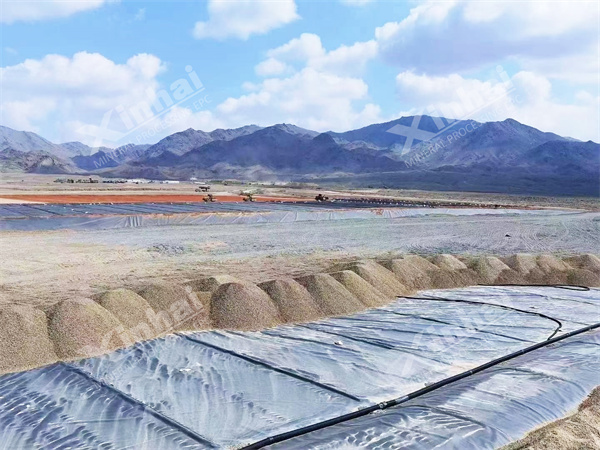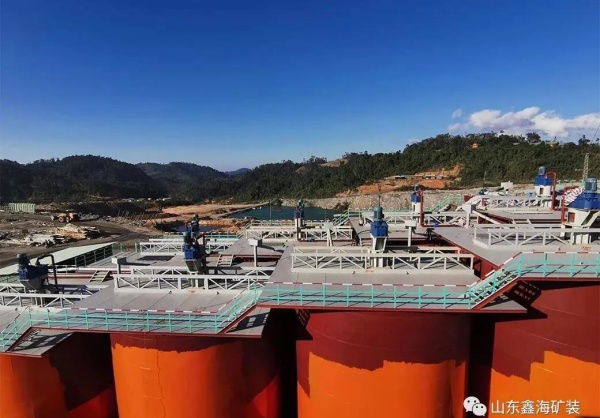Cyanide gold extraction is a commonly used method for gold ore dressing. Its principle is that in a cyanide solution, a complex of gold and cyanide reacts to form a monovalent gold into the solution. Cyanide gold extraction is just a general term for a gold ore processing process. The specific gold extraction methods should be divided into two types: cyanide leaching and sedimentation extraction. The following is a detailed introduction to the cyanide gold extraction method from these two aspects.
Cyanide leaching method for gold extraction refers to the process in which the gold in the gold-bearing ore reacts with cyanide to form a monovalent gold complex in a dilute cyanide solution and in the presence of oxygen (or oxidant) to dissolve into the solution to obtain a leachate. This method mainly includes two methods: pool leaching and heap leaching.

Pot leaching method for gold extraction is generally carried out in a percolation leaching pool. The leaching pool can be made of wood, iron or cement. The rules for making a leaching pool are: the bottom of the pool is horizontal or slightly inclined, and the shape can generally be round, square or rectangular. The bottom of the pool is covered with a false bottom to filter and support the ore. The material of the false bottom should be acid-resistant and have holes. The false bottom is covered with filter cloth, and the filter cloth is covered with a grille with wooden strips or corrosion-resistant metal strips. During the gold leaching process, the ore to be treated should be placed on the bottom of the pool, and the leaching agent should be poured on top, and the leaching liquid should flow out from the bottom of the false bottom.
The leaching time of the pool leaching method is affected by many factors, such as the dissolution rate of the solvent to the mineral, the penetration rate of the solvent in the material layer, etc. If you want to increase the penetration rate, you need to control the height of the loading, the porosity of the material, the sludge content, the viscosity of the leaching agent, etc. within a reasonable range.
The time required for leaching in the percolation pool depends not only on the dissolution rate of the solvent to the mineral, but also on the penetration rate of the solvent in the material layer. The penetration rate mainly depends on factors such as the loading height, the porosity of the material, the sludge content, the viscosity of the leaching agent, and the characteristics of the material itself.
The main operation method of heap leaching is to build a pile on the stockpile, and then spray or percolate with cyanide leaching solution. The principle is to make the cyanide leaching solution pass through the ore, thereby producing the effect of percolation and leaching, repeatedly spraying the ore pile, circulating the leaching solution multiple times, recovering the leaching solution, and then replacing gold with activated carbon or zinc.
Heap leaching is characterized by low cost and fast production, but its application scope is relatively narrow and it is only suitable for small-scale, low-grade gold ore processing plants.
The principle of sedimentation extraction is to extract gold from cyanide leaching solution. The process methods include zinc replacement method (zinc wire replacement method and zinc powder replacement method), activated carbon adsorption method (carbon slurry method CIP and carbon leaching method CIL), ion exchange resin method (resin ore slurry method RIP and RIL), electrolytic deposition method, magnetic carbon method, etc.
Zinc displacement gold process is a hydrometallurgical technology for extracting gold from gold-containing cyanide leaching solution. Its basic principle is to use the reducing property of metallic zinc to reduce the gold-cyanide complex in the solution and precipitate it into metallic gold.

The carbon-in-pulp gold extraction process (CIP and CIL) is to put activated carbon into the cyanide slurry, adsorb the dissolved gold on the activated carbon, and then extract the gold from the activated carbon. It mainly includes the preparation of leaching raw materials, stirring leaching and countercurrent carbon adsorption, gold-loaded carbon desorption, electrolytic electrolysis, smelting ingots, carbon regeneration and other operations.
Carbon-in-Pulp (CIP): First cyanide leaching, then add activated carbon to adsorb gold in the slurry;
Carbon-in-Pulp (CIL): Add activated carbon to the leaching tank, leaching and adsorption are carried out simultaneously, that is, leaching and adsorption.
In the CIP process, leaching and adsorption are two independent operations. In the adsorption operation, the leaching process has been basically completed, and the size, number and operating conditions of the adsorption tank are determined by the adsorption parameters. In the CIL process, leaching and adsorption operations are carried out simultaneously. Generally speaking, the leaching operation takes longer than the adsorption operation, so the size, aeration and dosing of the tank are determined by the leaching parameters. Since the adsorption rate is a function of the concentration of dissolved gold in the solution, in order to increase the concentration of dissolved gold in the front adsorption tank and increase the leaching time, 1 to 2 levels of pre-leaching are usually added before leaching and absorption.
This is a method of using ion exchange resin to adsorb and recover gold from cyanide slurry. It is divided into two gold extraction methods: RIP (resin slurry method) and RIL. The basic principle is that ion exchange resin can dissociate fixed ions and exchangeable ions in the solution. Since gold in cyanide slurry exists in the form of anion complex Au(CN)₂⁻, anion exchange resin must be used for gold extraction. The main steps involved in this process include adsorption, desorption and gold recovery.
Electrolytic deposition method for gold extraction is a method of extracting gold from a gold-containing solution using an electrochemical reaction. In the electrolytic cell, the gold-containing solution is used as the electrolyte. Through the action of direct current, the gold ions are oxidized into gold ions at the anode and then reduced and deposited into metallic gold at the cathode.
Magnetic carbon method for gold extraction is a process that uses magnetic activated carbon to adsorb gold and separates the ore pulp and carbon through a magnetic separator. The main difference between this method and the carbon pulp method is that the magnetic carbon method uses magnetic activated carbon, while the carbon pulp method uses ordinary activated carbon. The preparation of magnetic activated carbon is to bond magnetic powder and activated carbon together, and then dry and activate it. This activated carbon has better wear resistance.